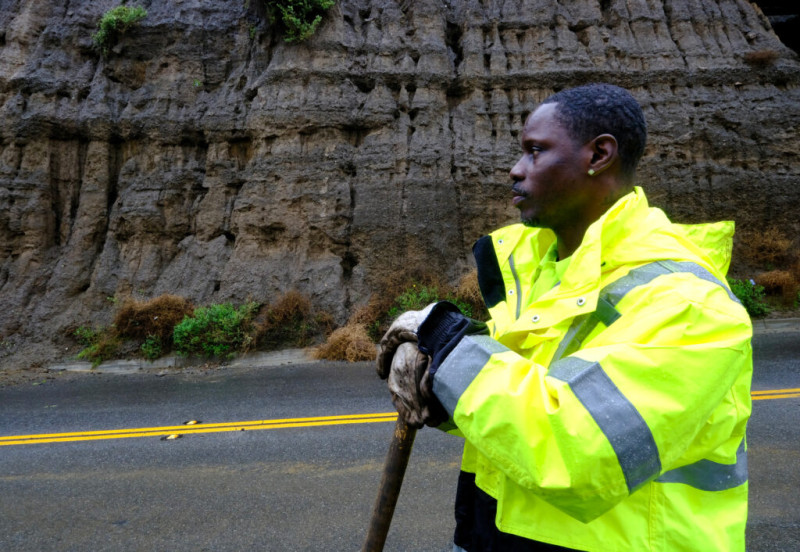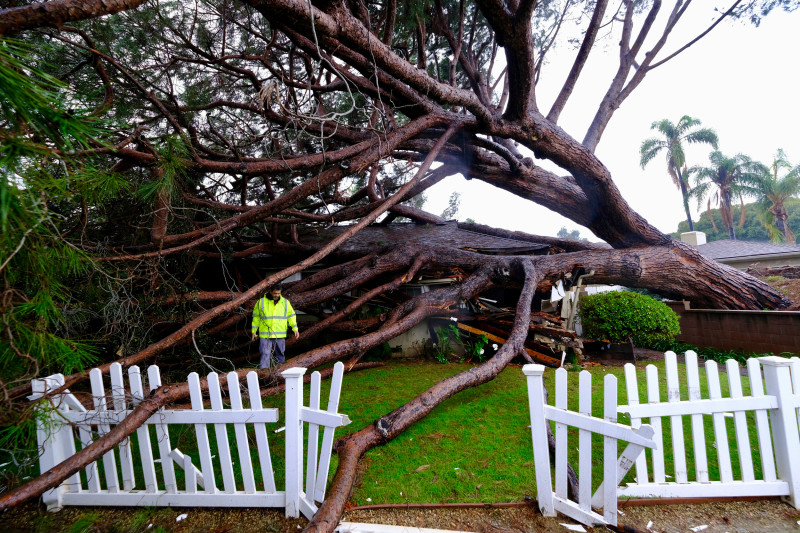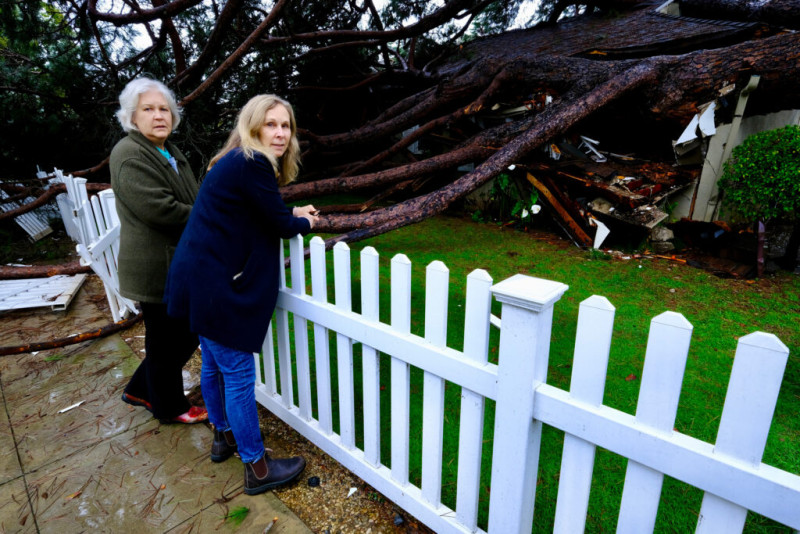Las Tormentas: L.A. County Meets a Next-Level Atmospheric River
LOS ANGELES—Around 9 p.m. on Sunday evening, Carol Sanborn and Jane Richardson were wrapping up a volunteer appreciation dinner at Corpus Christi Catholic Church in the Pacific Palisades neighborhood of Los Angeles when they heard something enormous, unidentifiable and explosive. Like seasoned Californians, they braced themselves for what would come next.
“We thought it was an earthquake, because that’s what we know,” said Richardson.
But the ground failed to rumble. Sanborn walked over to the parish hall door, ready to confront whatever had just attacked the church property on Toyopa Drive. “We opened the door,” she said, spreading her arms wide, “and there was just blackness.” They’d come eye-to-eye with the crown of a downed mediterranean stone pine.
The Western Coast of North America has long been under a unique climate threat: It’s a geographical bullseye for the meteorological mayhem of atmospheric rivers, Pacific-based storms that sweep up tropical moisture and dump it at the first land mass, typically California. As the Pacific Ocean warms and the air above it holds more moisture, climate scientists have predicted these storms will become super-loaded—“wetter, longer and wider.” Imagine the amount of water in the Amazon spilling all over one spot. Now double it. And this on a coast where even in cooler years, normal-grade atmospheric rivers have been responsible for more than 99 percent of all flood damage. Starting Sunday night, Los Angeles County got a terrible trailer for these climate-amped horror storms.
We’re hiring!
Please take a look at the new openings in our newsroom.
See jobsThat same hour, 20 miles east in downtown L.A., Estela Rodriguez was desperately trying to finish a $1,500 wedding order at Seeds of Love, her small, open flower stand on San Pedro Street. She placed roses, lilies, hydrangeas and Hawaiian tea leaves in foam blocks, in spite of rain pounding everything just beyond her awning.
The rain had started in the afternoon. Unlike the usual SoCal winter rainstorms that tend to hit and abate, this one was relentless. Extra water is fine at a flower’s stem, but it kills blossoms, and Rodriguez began to feel a sense of dread as she side-eyed the stand’s exposed buckets of “produce,” as they say in the business. She thought she should probably stop and move them all to the cooler, but she was on deadline. “I knew it was going to rain,” she said, “but not like this.”
By 10 p.m., Chris Jones had settled in for the night, watching TV at home in Compton. Jones had just turned 50 on Christmas Day and was proud of being real, born-and-raised L.A. He’d never taken paradise for granted, appreciating his decades of 70 degrees and low-humidity living. He worked outdoors up at the City of Santa Monica Streets Department, but was sanguine about an occasional rain shower, even the one tapping at his roof that night. Things had been so dry for years. “A little rain and everybody is pouting,” he said, refusing to be one of those spoiled Californians. He switched off the TV just so he could listen to it for a bit as he fell asleep.

There’s a tendency in the Los Angeles metro area to take what “officials” and “the news” might say about weather with one part shrug and one part suspicion. Hadn’t there been a huge to-do last August about Hilary, the Pacific hurricane that shut down Southern California in anticipation? It turned out not so bad, at least not in L.A. Just one rainy Sunday, punctuated by a mid-day, 5.1 magnitude earthquake centered in Ojai that was immediately dubbed the “hurriquake” on social media. The next morning, folks were back at the gym and then on to smoothies, work and tacos. The usual. So it felt logical this past Sunday, that despite a week of official warnings about an atmospheric river of potentially historic proportions (“Manténgase protegido durante las tormentas,” L.A. County had posted on X, Stay Protected During Storms), Trevor Noah began the Grammys at the Crypto.com Arena on S. Figueroa Street downtown with a joke about the locals struggling over plain old rain. “We’ll have a moment of silence for them later,” he said.
Before the live broadcast was over, though, cell phones all over Los Angeles began screeching with blaring “EMERGENCY ALERT” flash flood warnings from the National Weather Service that read in part:
This is a dangerous and life-threatening situation. Do not attempt to travel unless you are fleeing an area subject to flooding or under an evacuation order… Debris flows are imminent or occurring.
None of it was overblown. A vast storm system of cyclone-level winds and powerful rain cells that stretched all the way past Hawaii had swirled its way up and into California that day, first whipping the Northern and Central Coast parts of the state with winds clocked (in Big Sur) at 85 miles per hour, leaving more than a million people without power. As the system moved into Southern California that afternoon, it got wet. Not your average “Pineapple Express” rain cells, but something more akin to the Hurricane Harvey waterfalls that punished Texas and Louisiana in 2017. This rainstorm parked over places that don’t usually see Biblical downpours: the Santa Monica Mountains. That meant Hollywood, Beverly Hills, downtown Los Angeles, Brentwood, coastal towns like Santa Monica and all the canyon country in Los Angeles County faced flooding and mudslides of, as meteorologists often say in the significantly warmer, wetter climate of the 2020s, “historic proportions.” Lands celebrated for being sun-drenched were completely saturated by dark. And then the big trouble began.


The giant pine Carol Sanborn and Jane Richardson saw outside the church door on Sunday night had adapted to an earlier SoCal climate. It grew wide but shallow roots, perfect to soak up sparse rain or a little watering, but useless as anchors in suddenly sodden soil. The ladies were right: They had heard something akin to an explosion. The pine fell hard, crushing the roof of a historic convent on the church property. Sanborn and Richardson wouldn’t see the extent of the destruction until daybreak, but were overcome that night with a strange relief.
“That was the home of our beloved nuns, the Sisters of St.Louis, for 50 years,” said Sanborn. “Fortunately, they had moved out recently, so no one was in the convent. It’s just miraculous that nobody was hurt, no cars were parked there, nobody was walking by at that particular time.”
They’d be back early the next day to start making sense of what to do next, but first they had to get home safely. Toyopa Drive was quickly becoming, Richardson said, “a river.”
Estela Rodriguez woke up at 4 a.m. Monday morning, having only slept four hours. She’d finished the wedding flowers at a reasonable hour the night before but driving all the way home from downtown to Long Beach had been an ordeal. The highways Angelenos depend upon most, the North-South 405 and East-West 10, were not just clogged but water-logged.

“I tried to get to the freeway but it was stopped with an accident,” she said. “So I took side streets all the way to Long Beach, and I was nervous because it was a lot of water on those streets.”
Now, she had to make the commute again, back up the 405. It wasn’t as crowded as she expected—anyone who could was working from home on Monday at the encouragement of city officials. Rodriguez drove slowly, 50 mph tops, and arrived to open her flower stand by 5 a.m., only to find that she’d lost most of her inventory—the rain-soaked blossoms had fallen apart. And this during her busy season. “Valentine’s, we don’t sleep, we stay open sometimes three days with no sleeping. We have a lot of work to do,” she said. She’d have to regroup. A new delivery was coming, despite the abysmal forecast: another day of rain just as bad as before.
Chris Jones was due at the Streets Department in Santa Monica at 7 a.m. Monday morning, so he, too, was awake super-early, concerned about his commute. “I have a little four-cylinder Honda that can very easily get caught in a puddle and stall out,” he said. He set out from Compton, ready to turn around at the first sight of a hazard, but he made his way slowly from the 405 to the 10 to the coast. Word at work was that the rain had already caused a significant mudslide along the “California Incline,” a dramatic slope of a road that runs from the Palisade cliffs in Santa Monica down to the Pacific Coast Highway. Dump trucks and a front loader were already en route. Jones would be on shovel duty, scooping up mud and rocks that the machines couldn’t reach. He put on a good rain jacket, but arrived at the site in cotton work pants instead of coveralls, thinking the rain would let up. By lunch, he was “absolutely miserable, drenched.” Literal tons of heavy, sharp-edged, muddy debris had been trucked away, and he was looking at the cliff with new, storm-informed eyes. “All of these mudslides around the city, what’s to say this thing doesn’t give way? What’s holding it up?” he asked.
Tuesday dawned rainy yet again. Day 3 of a nameless storm that’s poured more than 11 inches of rain in parts of L.A. County and left houses crushed, cars upended in mud, roads blocked and an ocean toxic and sewage-soaked from millions of gallons of runoff. The atmospheric river looks to be pulling out of its parking space and finally heading South to Orange and San Diego counties in the afternoon. The risk of more cliff collapses and mudslides remains. Though three people died in Northern California, stuck by falling trees, no storm-related deaths have been reported in L.A. thus far. Angelenos are in the slog of recovery: calling the tree people, the insurance people, the building inspector, the towing company, the neighbors with a truck. Downtown on San Pedro Street, Estela Rodriguez has received a new delivery of red roses and has rigged a tarp to serve as an extra-long awning for her flower stand. She’s thinking about paying closer attention to the news next time, following the weather better. Nothing can be assumed about L.A. anymore, it’s just as much of a crapshoot climate as anywhere these days. But she’ll be readier.
“When I lose money, I learn my lesson!”
Share this article
Disclaimer: The copyright of this article belongs to the original author. Reposting this article is solely for the purpose of information dissemination and does not constitute any investment advice. If there is any infringement, please contact us immediately. We will make corrections or deletions as necessary. Thank you.







